Like a living tapestry, indoor vines can weave natural beauty throughout your home without demanding constant attention. You’ll discover that these ten beginner-friendly climbing plants offer the perfect balance of resilience and visual appeal, transforming bare walls and empty corners into vibrant spaces. Whether you’re working with bright windows or low-light areas, these adaptable botanical companions will help you create your ideal indoor sanctuary.
Contents
- 1 Pothos: The Adaptable Classic
- 2 Philodendron Brasil: Living Ribbons of Green
- 3 String of Pearls: Cascading Elegance
- 4 English Ivy: Timeless Beauty
- 5 Devil’s Ivy: The Indestructible Vine
- 6 String of Hearts: Delicate Charm
- 7 Monstera Adansonii: Swiss Cheese Magic
- 8 Wax Plant (Hoya): Sweet-Scented Climber
- 9 Spider Plant: Graceful Arches
- 10 Wandering Jew: Purple Paradise
Pothos: The Adaptable Classic
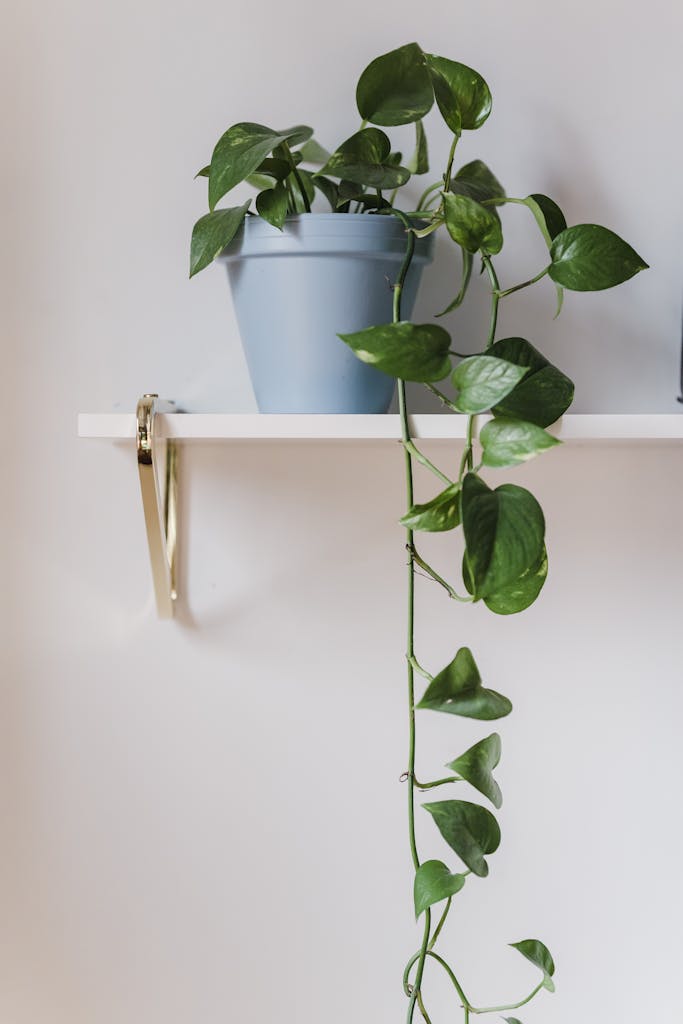
Pothos (Epipremnum aureum) is one of the most popular and foolproof indoor vines, prized for its heart-shaped leaves and trailing growth habit. This adaptable plant comes in several varieties, including golden, marble queen, and neon, each offering unique leaf variegation patterns. Known for its air-purifying qualities and resilient nature, pothos can thrive in various indoor conditions and forgives occasional neglect, making it perfect for both novice and experienced plant parents.
- Light: Tolerates low to bright indirect light; avoid direct sunlight which can burn leaves
- Water: Allow top 1-2 inches of soil to dry between waterings; water less in winter
- Soil: Well-draining potting mix; standard indoor potting soil works well
- Humidity: Adapts to normal household humidity but enjoys occasional misting
- Temperature: Thrives in average room temperatures between 60-80°F (15-27°C)
- Fertilizer: Feed monthly with balanced liquid fertilizer during growing season
- Container: Any well-draining pot with drainage holes; can grow in water
- Propagation: Easy to propagate through stem cuttings in water or soil
Philodendron Brasil: Living Ribbons of Green
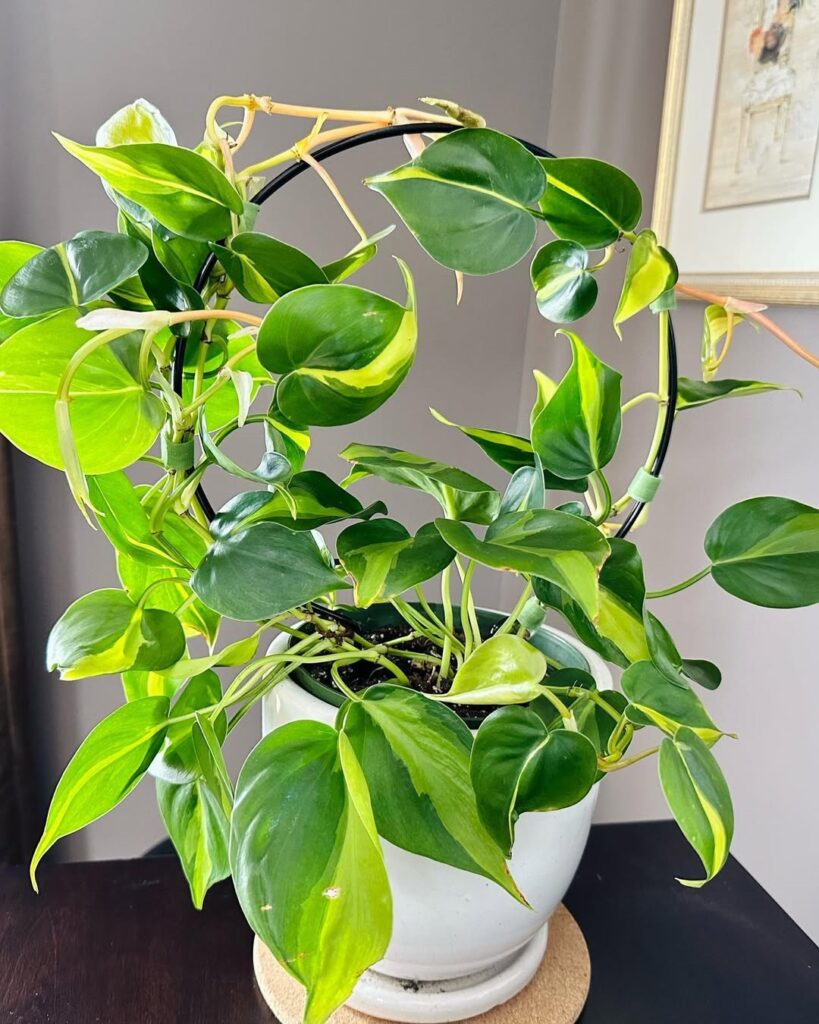
Philodendron Brasil is a striking tropical vine characterized by its heart-shaped leaves featuring vibrant lime-green variegation along dark green foliage. This easy-to-grow houseplant trails elegantly from hanging baskets or climbs up moss poles, making it a versatile choice for indoor spaces. The vines can reach impressive lengths when properly maintained, and its glossy leaves create a cascading effect that adds natural drama to any room.
- Light: Bright, indirect light; can tolerate medium light but avoid direct sun exposure
- Water: Allow top 1-2 inches of soil to dry between waterings; reduce frequency in winter
- Soil: Well-draining potting mix rich in organic matter
- Humidity: Moderate to high; thrives in 50-60% humidity
- Temperature: 65-80°F (18-27°C)
- Fertilizer: Monthly feeding with balanced liquid fertilizer during growing season
- Support: Provides moss pole or trellis for climbing growth
- Container: Pot with adequate drainage holes
String of Pearls: Cascading Elegance
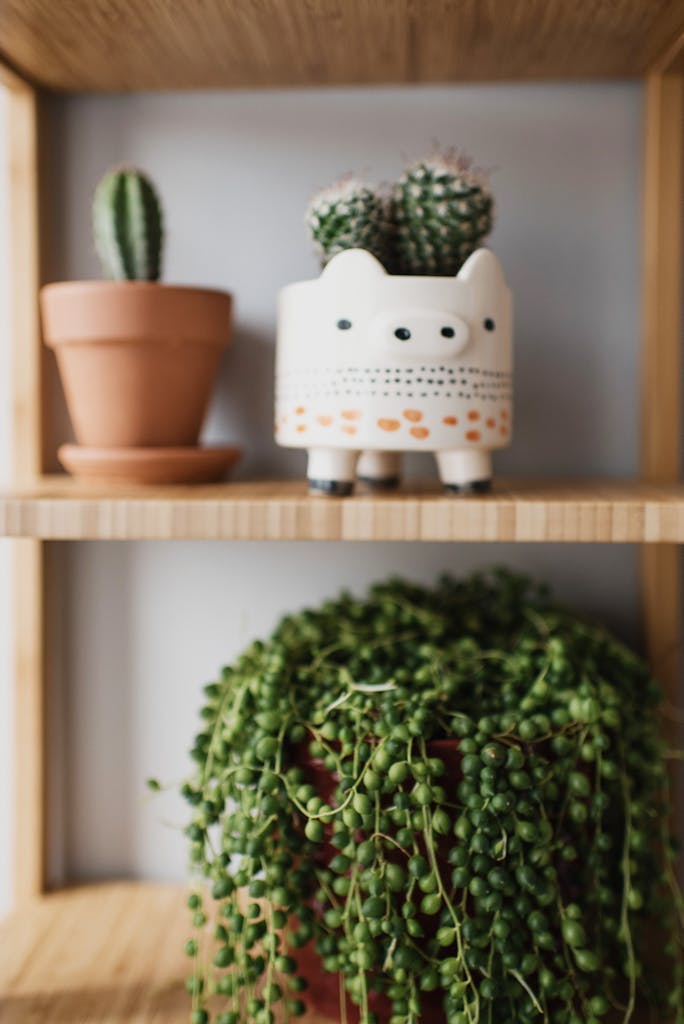
String of Pearls (Senecio rowleyanus) is a distinctive trailing succulent vine known for its delicate strands of small, spherical leaves that resemble green pearls strung together. This unique plant creates a dramatic cascading effect when placed in hanging baskets or allowed to spill over the edges of elevated containers, making it a popular choice for adding visual interest to indoor spaces. The individual pearl-like leaves store water, allowing the plant to withstand periods of drought, while its trailing stems can grow several feet long when properly maintained.
- Light: Bright, indirect sunlight; can tolerate some direct morning sun but protect from harsh afternoon light
- Water: Allow soil to dry completely between waterings; water sparingly in winter
- Soil: Well-draining succulent or cactus mix
- Humidity: Tolerates average indoor humidity levels
- Temperature: 70-80°F (21-27°C); can survive brief periods at 50°F (10°C)
- Container: Pots with drainage holes; hanging baskets or elevated planters ideal
- Fertilizer: Light feeding with balanced fertilizer during growing season
- Propagation: Easily propagated through stem cuttings
English Ivy: Timeless Beauty
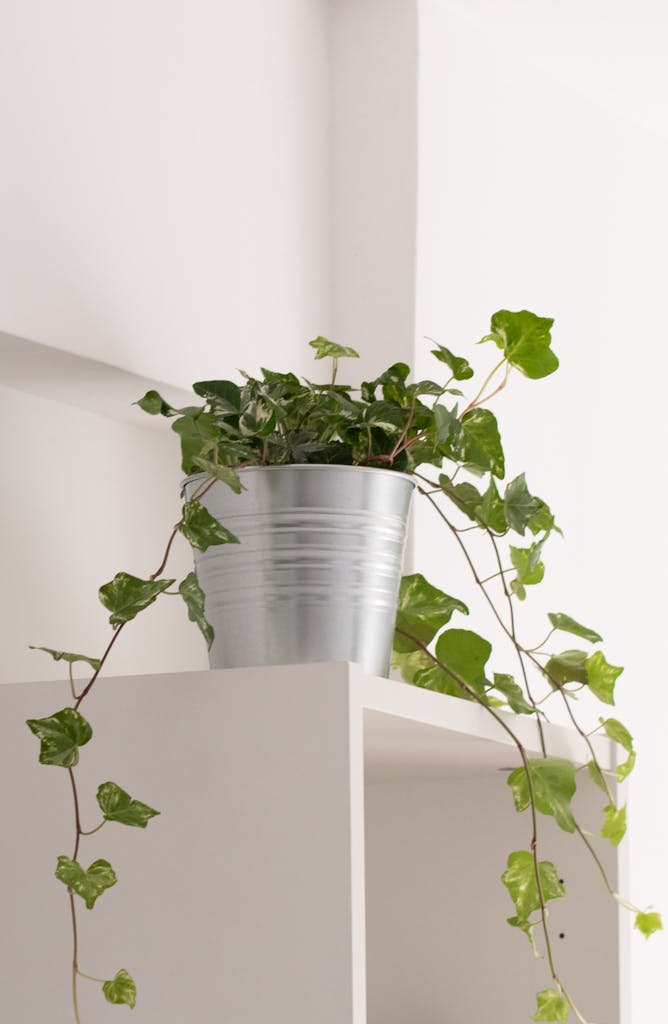
English Ivy (Hedera helix) is a classic climbing vine known for its elegant, glossy green leaves and versatile growth habit. This timeless plant can gracefully trail from hanging baskets, climb walls with its aerial roots, or create dense ground cover. Its distinctive lobed leaves come in various patterns and sizes, from deep green to variegated forms, making it a popular choice for both traditional and modern interior spaces.
- Light: Bright indirect light to partial shade; avoid direct sunlight which can scorch leaves
- Water: Keep soil consistently moist but not waterlogged; allow top inch of soil to dry between waterings
- Soil: Well-draining potting mix rich in organic matter
- Humidity: Prefers moderate to high humidity; regular misting benefits growth
- Temperature: Thrives in cool to average room temperatures (60-70°F)
- Fertilizer: Feed monthly during growing season with balanced liquid fertilizer
- Support: Provide trellis, moss pole, or other climbing structure for vertical growth
Devil’s Ivy: The Indestructible Vine

Devil’s Ivy, also known as Pothos or Epipremnum aureum, is a hardy and versatile climbing vine beloved by both novice and experienced plant enthusiasts. Its heart-shaped leaves display various patterns of green and yellow variegation, and the plant can grow several feet long when properly maintained. True to its “indestructible” nickname, Devil’s Ivy can tolerate a wide range of growing conditions and bounces back easily from neglect, making it one of the most forgiving houseplants available.
- Light: Tolerates low to bright indirect light; avoid direct sunlight which can scorch leaves
- Water: Allow top 1-2 inches of soil to dry between waterings; can withstand occasional drought
- Soil: Well-draining potting mix; thrives in standard houseplant soil
- Humidity: Adapts to normal household humidity; benefits from occasional misting
- Temperature: Prefers 60-80°F (15-27°C)
- Fertilizer: Feed monthly with balanced liquid fertilizer during growing season
- Container: Any well-draining pot; can be grown in water
- Pruning: Trim leggy vines to promote bushier growth
String of Hearts: Delicate Charm
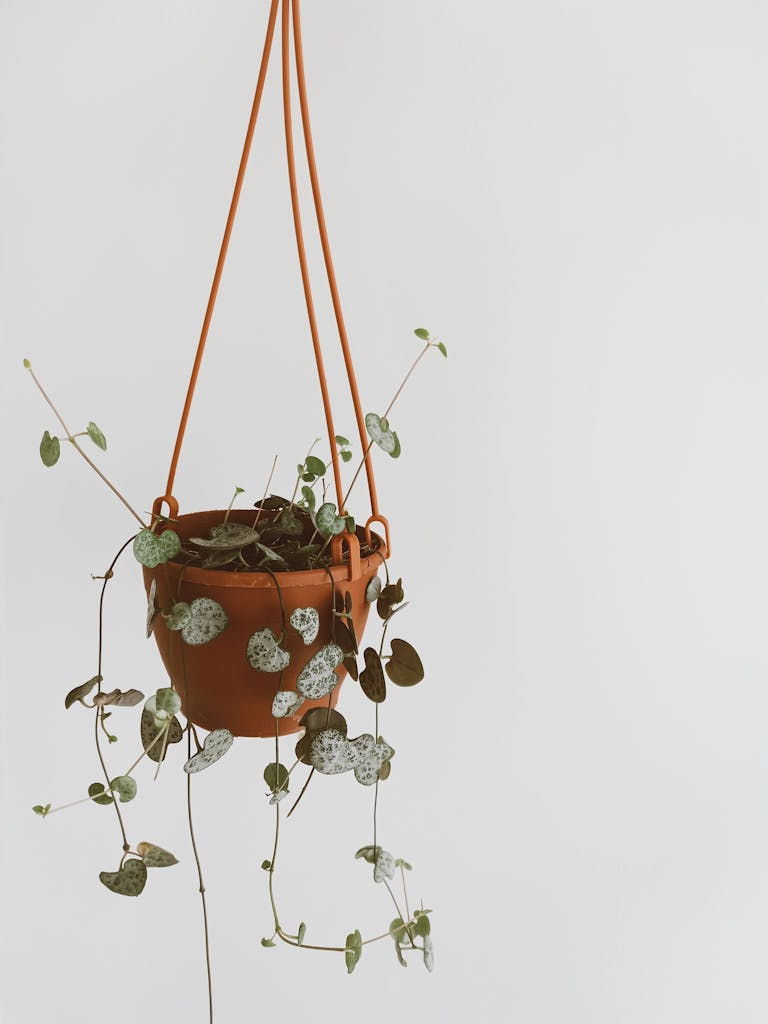
String of Hearts (Ceropegia woodii) is a dainty trailing vine known for its delicate heart-shaped leaves that cascade down in long, slender chains. Each leaf features an attractive marbled pattern of silvery-green and purple hues, creating an elegant display that makes it perfect for hanging baskets or high shelves. This low-maintenance South African native grows quickly under proper conditions and can trail up to 12 feet long when mature.
- Light: Bright indirect light; can tolerate some direct morning sun; protect from harsh afternoon sunlight
- Water: Allow soil to dry between waterings; water sparingly in winter; susceptible to root rot if overwatered
- Soil: Well-draining succulent or cactus mix
- Temperature: 65-80°F (18-27°C); can tolerate down to 60°F (15°C)
- Humidity: Adaptable to average home humidity; does not require high humidity
- Fertilizer: Feed with diluted balanced fertilizer monthly during growing season
- Pot: Use containers with drainage holes; shallow pots are preferred as roots are not deep
Monstera Adansonii: Swiss Cheese Magic

The Monstera adansonii, commonly known as the Swiss Cheese Vine, is a stunning tropical vine prized for its unique fenestrated leaves with distinctive oval holes. This climbing plant grows naturally in the rainforests of Central and South America, where it uses aerial roots to climb trees and other supports. As a houseplant, it can reach impressive lengths when properly supported, making it perfect for trellises, moss poles, or allowing it to cascade from hanging baskets. The heart-shaped leaves start small and develop their characteristic holes as they mature, creating an elegant and eye-catching display.
- Light: Bright, indirect light; avoid direct sunlight which can burn leaves; can tolerate medium light conditions
- Water: Keep soil consistently moist but not waterlogged; water when top 1-2 inches of soil feels dry
- Soil: Well-draining, rich potting mix with added perlite and orchid bark
- Humidity: High humidity (60-80%); benefits from regular misting or humidifier
- Temperature: 65-80°F (18-27°C); protect from cold drafts
- Support: Provide trellis, moss pole, or other climbing support
- Fertilizer: Feed monthly during growing season with balanced liquid fertilizer
- Soil pH: 5.5-7.0
- Pot Type: Container with drainage holes
- Propagation: Easily propagated through stem cuttings in water or soil
Wax Plant (Hoya): Sweet-Scented Climber
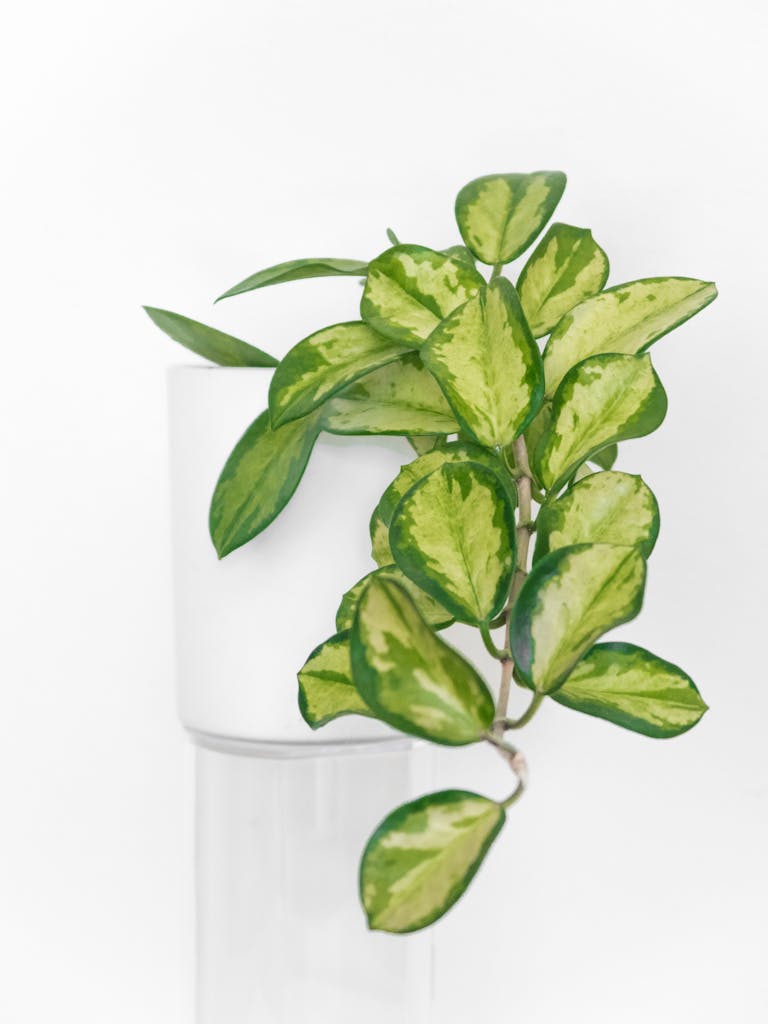
The Wax Plant (Hoya) is a tropical climbing vine known for its thick, waxy leaves and clusters of star-shaped, porcelain-like flowers that emit a sweet fragrance. This long-lived indoor plant grows slowly but can reach impressive lengths when properly supported, making it perfect for hanging baskets or trellises. Its succulent-like leaves store water, allowing the plant to tolerate occasional neglect, while its beautiful blooms appear on specialized stalks called spurs that should never be removed, as they produce new flowers year after year.
- Light: Bright, indirect sunlight; can tolerate some direct morning sun; avoid harsh afternoon light
- Water: Allow soil to dry between waterings; reduce watering in winter
- Soil: Well-draining potting mix with orchid bark or perlite
- Humidity: Moderate to high; benefits from occasional misting
- Temperature: 60-80°F (15-27°C); protect from cold drafts
- Fertilizer: Feed monthly during growing season with balanced fertilizer
- Support: Provide trellis, poles, or hanging support for climbing
- Container: Use pot with drainage holes; prefer to be slightly rootbound
Spider Plant: Graceful Arches

Spider Plants (Chlorophytum comosum) create elegant cascading arches with their slender, variegated leaves and dangling plantlets, making them perfect for hanging baskets or elevated shelves. Their graceful, arching growth pattern produces long stems with baby plants at the ends, which can easily root to create new plants, adding to their appeal as an indoor vine.
- Light: Bright to moderate indirect light; avoid direct sunlight
- Water: Allow top inch of soil to dry between waterings; tolerates occasional drought
- Soil: Well-draining potting mix rich in organic matter
- Humidity: Adaptable to average home humidity levels
- Temperature: 60-75°F (15-24°C)
- Fertilizer: Light feeding with balanced fertilizer every 2-3 months during growing season
- Container: Hanging basket or pot with drainage holes
- pH: 6.0-7.2
Wandering Jew: Purple Paradise
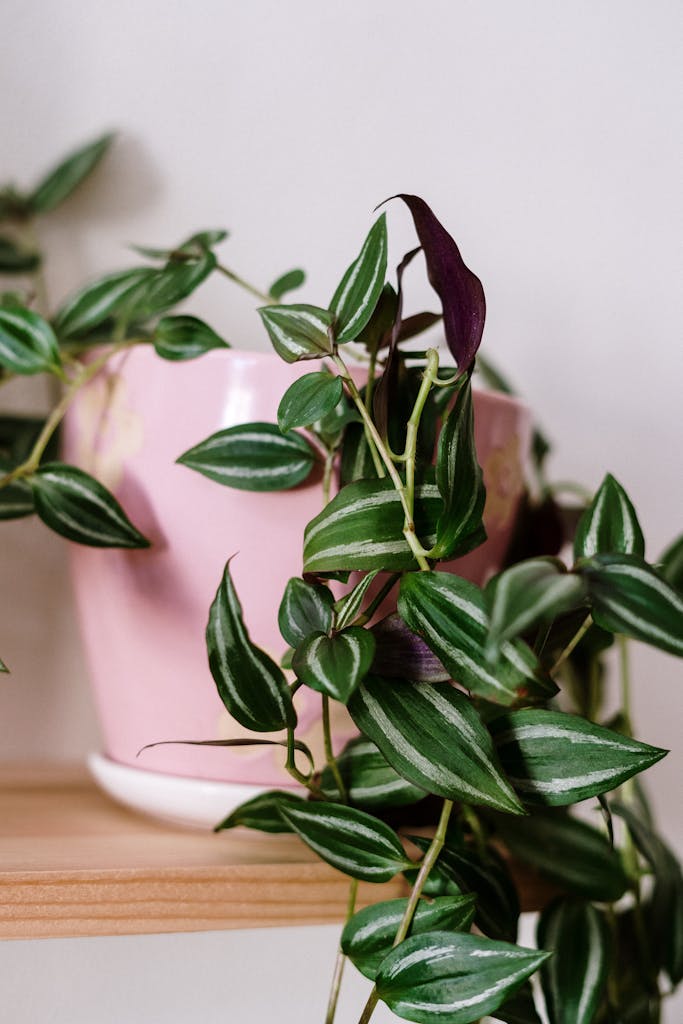
The Wandering Jew (Tradescantia zebrina) is a vibrant, trailing vine known for its striking purple and silver striped foliage. This fast-growing plant features elongated, pointed leaves with metallic sheen and produces small purple flowers in ideal conditions. Its cascading nature makes it perfect for hanging baskets or elevated planters, where its stems can gracefully spill over the edges, creating a dramatic display of color.
- Light: Bright, indirect sunlight; can tolerate some direct morning sun but avoid harsh afternoon light
- Water: Keep soil consistently moist but not waterlogged; water when top inch of soil feels dry
- Soil: Well-draining, rich potting mix
- Humidity: Moderate to high; mist regularly or use a humidity tray
- Temperature: 60-80°F (15-27°C)
- Fertilizer: Feed monthly during growing season with balanced liquid fertilizer
- Pruning: Trim regularly to maintain shape and promote bushier growth
- Propagation: Easy to propagate through stem cuttings in water or soil
